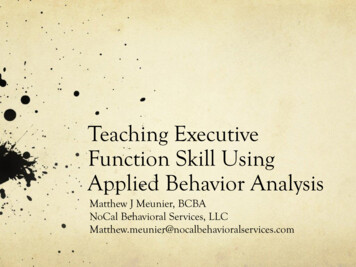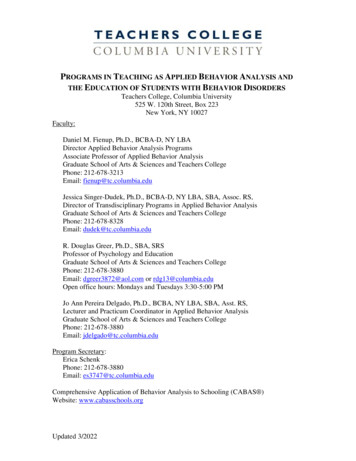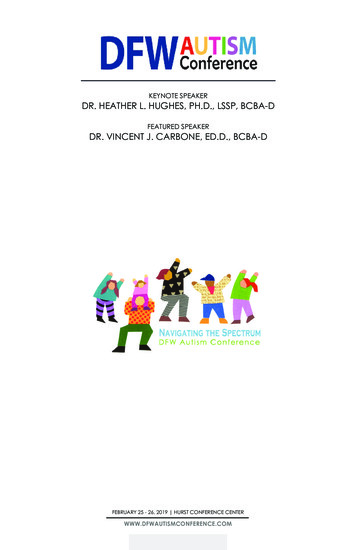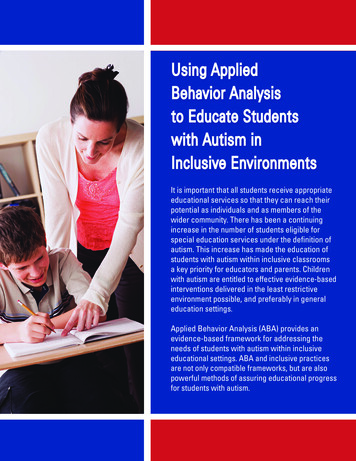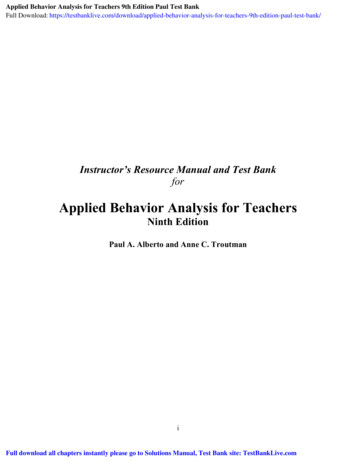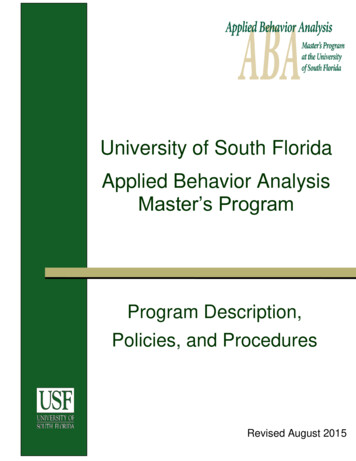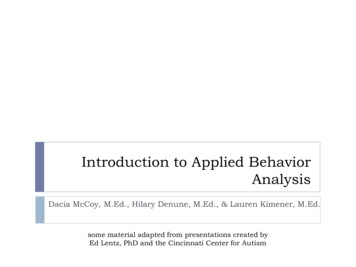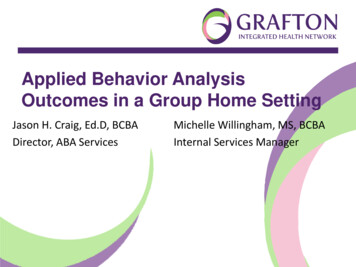
Transcription
Applied Behavior AnalysisOutcomes in a Group Home SettingJason H. Craig, Ed.D, BCBADirector, ABA ServicesMichelle Willingham, MS, BCBAInternal Services Manager
Objectives Discuss the evolution of Grafton’s ABA program Understand the levels of care within Grafton’s Community Based Group HomesGiven the funding rules, discuss how behaviortherapy fits in?Look at some outcomesDiscuss some challenges and forward looking ideas
Grafton’s Continuum of Care and theDevelopment of ABA Services A Brief Story of Ruth Birch and Grafton Community Based Group Home Services
Grafton’s Continuum of Care and theDevelopment of ABA Services Applied Behavior Analysis (ABA) Intentions– Legislation and Momentum Insurance Mandate, CMS Mandate, and Medicaid CoverageIn-Home Services for Children Applied Behavior Analysis (ABA) Interest and Growth– Therapeutic Consultation for Adults– Third Party Consultation and Classroom Oversight– Dedicated ABA Classrooms
Applied Behavior Analysis (ABA)Interest and Growth Early Intervention through Part CDementiaTBIGrants and ResearchABA as a Related Service within Core GraftonServices– Educational Services– Consultation– Group Home Supports
The PastGrafton’s Community Based Group Homes wereconsidered to be a Level C care environment due tothe acuity of our population
Residential Treatment Center (RTC)Level C A 24-hour-per-day specialized form of:– Highly organized,– Intensive, and– Planned therapeutic interventions Utilized to treat severe:– Mental,– Emotional, and– Behavioral disorders.
Residential Treatment Center (RTC)Level C A modality designed to deliver specified results for adefined group of problems for children oradolescents under the age of 21 for whom:– Outpatient day treatment or other less intrusive levels ofcare are not appropriate,– Child-specific care and treatment planning is required, and– A protected, structured milieu is medically necessary foran extended period of time.
Residential Treatment Center (RTC)Level C The services provide are:––––Highly organized and intensive services;Planned therapeutic interventions;Provided on-site, including academic programming; ANDPhysician-directed mental health treatment. ABA was only authorized as a support service thatcould be used to transition individuals into lesserrestrictive environment
Clarification on How that Works Behavior Therapy services through Medicaid underEarly and Periodic Screening, and Diagnosis andTreatment (EPSDT) could be used to facilitatetreatment after the transition to home from an outof-home placement when services more intensivethan outpatient care was required for the transitionto be successful.– Behavior Therapy was defined to include Applied BehaviorAnalysis (ABA) and Intensive In-Home (IIH) services Time for an ABA detour
EPSDT Behavioral Therapy This service is covered by DMAS because: Any treatment service which is not otherwise coveredunder the State’s Plan for Medical Assistance can becovered for a child through EPSDT as long as the service isallowable under the Social Security Act Section 1905(a)and the service is determined by the Department ofMedical Assistance Services (DMAS) or its agent asmedically necessary. Board of Medicine Oversight
Board of Medicine Oversight EPSDT Behavioral Therapy must be provided byeither:––––An LMHP acting within the scope of their practiceAn LBAAn LABA under the supervision of a LBA orPersonnel under the supervision of a LBA or LABA inaccordance with 18VAC85-150-10 et seq. of the VirginiaBoard of Medicine regulations.
ELIGIBILITY CRITERIAEPSDT Behavioral Therapy May be provided to persons with developmental or intellectual delays.Children must exhibit intensive behavioral challengesto be authorized for services.Under 21 years of age and enrolled in MedicaidHave a medical need identified by the child’sphysician, nurse practitioner, or physician assistantthrough an inter-periodic/problem-focused visit oran EPSDT screening/well-child visit.
NECESSITY CRITERIAEPSDT Behavioral Therapy The individual must be medically stable to benefit from treatment at this level of care;The individual must have a current psychiatricdiagnosis as defined in the Diagnostic and StatisticalManual of Mental Disorders (DSM) that is relevant tothe need for behavioral therapy or have a provisionalpsychiatric diagnosis as developed by an LMHP whenno definitive diagnosis has been made;
NECESSITY CRITERIAEPSDT Behavioral Therapy The individual must meet at least two of the followingcriteria on a continuing or intermittent basis:– Non-verbal or limited functional communication and pragmaticlanguage, unintelligible or echolalic speech, impairment inreceptive and/or expressive language.– Severe impairment in social interaction /social reasoning /socialreciprocity/ and interpersonal relatedness.– Frequent intense behavioral outbursts that are self-injurious oraggressive towards others.– Disruptive obsessive, repetitive, or ritualized behaviors.– Difficulty with sensory integration;
ELIGIBILITY CRITERIA - EPSDTBehavioral Therapy Treatment that cannot be provided by another program or a lower level of care/serviceLess intensive treatment modalities have been ruled out,or have been unsuccessful in effectively modifying thetarget behaviorThe individual must be willing to participateFamily and caregivers lack the skills needed to effectivelymanage the individual’s behaviors in the homeenvironment and training is necessaryAt least one family member or caregiver must be able toparticipate
EPSDT Behavioral TherapySo how is ABA defined? ABA is the practice of behavior analysis asestablished by the Virginia Board of Medicine in§ 54.1-2900 as:– The design, implementation, and evaluation ofenvironmental modifications using behavioral stimuli andconsequences,– To produce socially significant improvement in humanbehavior,– Including the use of direct observation, measurement, andfunctional analysis of the relationship betweenenvironment and behavior.
EPSDT Behavioral Therapy Systematic interventions provided by licensed practitioners within their scope of practiceDesigned to enhance communication skills anddecrease maladaptive patterns of behavior which, ifleft untreated, could lead to more complex problemsand the need for a greater or a more restrictive levelof care.For individuals in the home
EPSDT Behavioral Therapy“HOME” The service goal is to ensure the individual’s family is trained to effectively manage the individual’s behavior in the homeusing behavioral modification strategies.Home is the family residence and includes:–––––A child living with natural parents,A child living with adoptive parents,A child living with relatives,A child living with a guardian,A child living in the family residence of the child’s permanent fostercare placement– A child living in the family residence of the child’s temporary fostercare placement– A child living in the family residence of the child’s permanent preadoption placement– A child living in the family residence of the child’s temporary preadoption placement
SERVICE DESCRIPTIONEPSDT Behavioral Therapy Family involvement in therapy is meant to increase the child’s adaptive functioning by training the familyin effective methods of behavioral modificationstrategies.Direct family involvement in the treatment programis required but the amount of direct interaction withthe treatment provider will vary according to theclinical necessity and progress as documented.
SERVICE DESCRIPTIONEPSDT Behavioral Therapy Therapy services are provided within the everyday routines and activities in which families participate,and in places where the family would typically be sothat their daily life is supported.At times it may be necessary and appropriate toprovide therapy services in an “atypical” or“alternative” location.– This would apply when the home environment is not safefor the therapist, or when helping the individual tomanage maladaptive behaviors outside the home incommunity settings.
SERVICE DESCRIPTIONEPSDT Behavioral Therapy Used to increase appropriate social /communicativeinteractions and pivotal responses within a socialframework. Increase adaptive functioning and produce beneficialchanges in pivotal responses that result in morewidespread behavioral change across a number of othernon-targeted behaviors. Behavioral therapy must be coordinated with othermedical services to effectively increase adaptivefunctioning. Services such as speech-language pathology services,occupational therapy or psychiatric care must becoordinated with and integrated with the behavioraltherapy plan.
SERVICE DESCRIPTIONEPSDT Behavioral Therapy TRANSITION– Behavioral therapy may be used to facilitate the transition homefrom an out-of-home placement when services more intensivethan outpatient clinic care are required for the transition to besuccessful. “Out-Of-Home” Defined:––––––Level A or Level B Group HomeRegular or Treatment Foster HomeLevel C Residential FacilityEmergency shelterPsychiatric hospitalizationJuvenile Justice / Incarceration Placement
COVERED SERVICES Development of initial and updated ISPs, Assessments, and Treatment PlansSupervision and delegation activities by LBABehavioral training to increase the individual’s adaptivefunctioning and communication skills;Training of family members to improve the child’sadaptive skills in the home and community;Documentation and analysis of quantifiable behavioraldata related to treatment objectives;Behavioral modification services and direct consultationby the LBA or LABA with direct services staff
LIMITATIONS Assessments are allowed for up to 5 hours per child and must be done face-to-faceAll treatment service hours require serviceauthorizationSupportive services in a school setting.Children who meet the eligibility requirements toreceive Community Mental Health Rehabilitation(CMHRS) are not eligible for EPSDT BehavioralTherapy.
Community Mental HealthRehabilitation (CMHRS) Services Therapeutic Day Treatment for Children and Adolescents Community-Based Residential Services for Children and Adolescents Under 21(Level A)Therapeutic Behavioral Services (Level B)Day Treatment/Partial HospitalizationPsychosocial RehabilitationCrisis InterventionIntensive Community TreatmentCrisis StabilizationAnd more
The Almost PresentIt was then Deemed that Grafton’s CommunityBased Group Homes were more of a Level B CareEnvironment, then a Level C Care Environment
Therapeutic Behavioral ServicesLevel B: Service Definition Therapeutic Behavioral Services for Children and Adolescents under 21A combination of therapeutic services that providestructure to ensure the attainment of therapeuticmental health goals as identified in the ISP:––––Daily activities,Psycho-education,Therapeutic supervision and treatment, andMental health care The individual must also receive individual and grouppsychotherapy services, at least weekly, in additionto therapeutic residential services.
Therapeutic Behavioral ServicesLevel B: Eligibility Criteria Individuals qualifying for this service mustdemonstrate medical necessity for the service arisingfrom a condition due to:– Mental, behavioral, or emotional illness,– Which results in significant functional impairments inmajor life activities in the home, school, at work, or in thecommunity. The service must reasonably be expected to improvethe individual’s condition or prevent regression sothat the services will no longer be needed.
Therapeutic Behavioral ServicesLevel B: Eligibility Criteria The individual is medically stable, but needs intervention to comply with mental healthtreatment; ANDThe individual’s needs cannot be met with a lessintense service; ANDAn assessment demonstrates at least two areas ofmoderate impairment in major life activities.
Staffing for Level B To assist in assuring client safety, the agency mustprovide adequate supervision of individuals at alltimes, including off campus activities.– The staff ratio must be at least 1 staff to 4 children duringthe day– At least 1 staff to 8 children while the children/adolescentsare scheduled to be asleep
Continued Stay Criteria for Level B Service authorization through Magellan A qualified mental health provider (QMHP) must re assess for medical necessity and a licensed mentalhealth provider (LMHP) must sign offDaily documentation of individualized supervisionand structure to minimize the occurrence ofbehavioral issuesMovement toward stated goals and objectives
Continued Stay Criteria for Level B Psycho-educational programming that includes, but isnot limited to development or maintenance of:––––––Daily living skills,Anger management,Social skills,Family living skills,Communication skills, andStress management. Psycho-education refers to education on mental healthtopics to improve the individual’s behavioral, mental, oremotional condition.
Continued Stay Criteria for Level B The individual must participate in seven (7) psycho educational activities per week.In addition to the residential services, the individualmust receive at least weekly, individualpsychotherapy that is provided by a LMHP.Family psychotherapy may also to be provided ifthere is continued family involvement.Individuals must also receive group psychotherapythat is provided as part of the program.
The PresentIt was Decided that Grafton’s Community BasedGroup Homes are to be treated as a Level B CareEnvironment under a Specialized ContractAgreement Based on the Population Served Grafton is working with stakeholders in Medicaid to develop amanual to expand the model
Level BSpecialized Contract Agreement Meet the requirements listed in the CommunityMental Health Rehabilitation Manual specific to LevelB Group Homes with the specialized adaptations.– Documentation for continuation requests under EPSDTmust include an updated comprehensive individual serviceplan signed by a physician, nurse practitioner or physicianassistant as well as a licensed mental health provider.– An updated clinical summary must also accompany therequest for continuation of coverage that includes updatedplans for preparing member for discharge to a lower levelof care as appropriate.
Level BSpecialized Contract Agreement Psychotherapy (Individual, Group, and Family) is onlyprovided when clinically indicated in the plan of careand the client can actively participate in this level oftreatment. Clients who are not able to participate in verbaltherapy will receive behavior modification treatmentsessions as medically indicated in the plan of care.
Included Per Diem Services Interdisciplinary treatment including behavioral modification therapiesDischarge planningNursingBehavioral support counselorsEquipment necessary to implement the treatmentprogramClinical Supervision related to the treatment planCase ManagementTreatment Team Activity
Excluded Per Diem Services Any general medical needs not addressed in the per Diem servicesDurable medical equipment or non-routine medicalsuppliesMedical consultation and diagnostic testing outside ofthe treatment facilityAny other service not specifically noted as includedwithin the Inclusive Per Diem services listed abovePsychotropic medications, as evaluated and physicianorderedProfessional services
What Grafton Wanted to Do Redefine “HOME” to include a community based group homeIncrease the amount of direct individual servicesprovided by EPSDT Behavior Therapy for the ID/DDpopulations, ANDProvide and integrated clinical structure based onmedical necessity– ABA Philosophy vs. Practice
Results to Coverage Inquiry Providing ABA Services in a Level B Care Environmentis:– A locality decision that is child specificand distinctly defined as an add-onservice
What Grafton Did 940 Group Home– Concentrated population of clients with approve ABAservices– QMHP that is a BCBA– Integrated Behavior Specialists under the supervision of aBCBA– RBT trained residential instructors The world of insurance leaves some doors open Now lets look at some outcomes
Overall GH OutcomesPercentage IncreasesPercentagesGoal MasteryStudent EngagementTheraputic DSPEngagementSupplementary AidesToiletingGoal MasteryBaselineQ2StudentEngagementTheraputic DSP SupplementaryEngagementAidesToileting
Individual Case Studies120MA Goal Mastery100DIS BX80AE BXOT HandSLP Y/N Qes60Civis ACADRead ACADMath ACAD40Patt ACAD1 Step dir SLP200JulAugSepOctNovDec
Individual Case Studies140JC Goal Mastery BaselineToil ABAHYG IN ABA120Label SLPMTS SLPBreak ABA1007 Mands ABA10 Tacts ABA8020 Imi ABATA SNACK ABA15 req SLP6015 LR field 3 SLPTrace Let OT40Read ACADLF Scien ACAD20Phy SCI ACADCar and Tech ACADAGG BX0JulAugSepOctNovDecSIB BX
Individual Case Studies80MG Goal Mastery70Wh ques SLPMath ACADCivics ACAD60Comm H&W ACADEco ACAD50Request SLPImpro F/Th BXProp Des BX40PA BXMand ABA30Tact ABAIMIT ABATransi ABA20On task OTInapp Touch BX10PA when Wait BX0JulAugSepOctNovDec
Individual Case Studies120NM Goal Mastery100MTS letters AcadMTS number Acad80Weather AcadCom helper ACAdDisrup BXelope BX60elope ABAeating ABAdisrobing ABA40tantrum ABAMTS let to name AcaMTS number to obj Aca200JulAugSepOctNovDec
What about the Future? Work down from a LRE Continuum–––––Level B with ABALevel BPublic School Based ClassroomsPublic School Based Services with In-Home SupportsConsultative Services Should we start at the bottom?
Consultative Outcomes
Consultative Outcomes
Consultative Outcomes
Questions? What are the outcomes necessary for movement along the continuum?What is needed to transition back to a locality?What supports are needed to make that transitionsuccessful?Who owns that decision?Would case rate/performance based contracting bean option?
Contact Informationjason.h.craig01@grafton.org
Applied Behavior Analysis (ABA) Intentions -Legislation and Momentum Insurance Mandate, CMS Mandate, and Medicaid Coverage In-Home Services for Children Applied Behavior Analysis (ABA) Interest and Growth -Therapeutic Consultation for Adults -Third Party Consultation and Classroom Oversight -Dedicated ABA Classrooms
